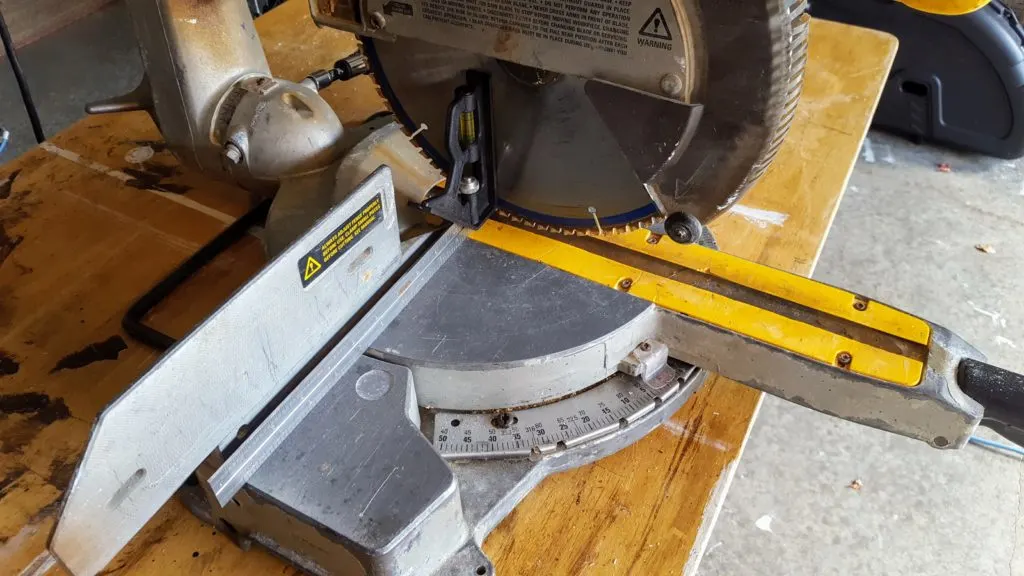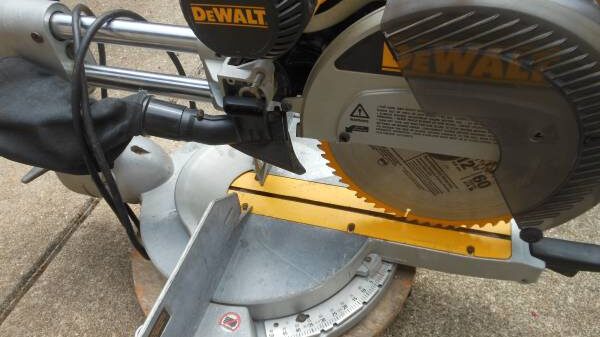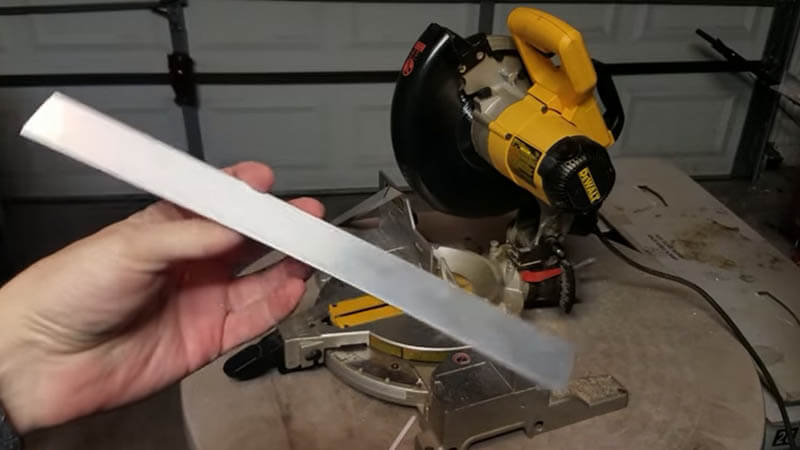Welcome to the world of DIY enthusiasts and handy artisans! If you’ve ever wondered, “Can I cut aluminum with a miter saw?” – you’re in the right place. Aluminum is a versatile and lightweight material used in various projects, from framing windows to constructing intricate designs. Many of us are familiar with miter saws, those trusty tools designed for making precise cuts in wood.
But can they handle Aluminum, too? In this guide, we’ll explore the compatibility of miter saws with Aluminum and provide the knowledge and tips you need to safely and effectively work with this metal using your miter saw. So, let’s dive in and answer the question: Can I cut Aluminum with a miter saw?
Factos that affect cutting into Aluminum with a Miter Saw
Cutting Aluminum with a miter saw can be a helpful technique in various applications, but a few elements should be considered to guarantee a protected and compelling cutting process. Here are the factors that can affect cutting into Aluminum with a miter saw:
Blade Type: The choice of blade is crucial when cutting Aluminum. Use a carbide-tipped, non-ferrous metal cutting blade designed explicitly for Aluminum. These blades have teeth designed to cut through soft metals like Aluminum without clogging or generating excessive heat.
Blade Size: Ensure that the diameter of the blade is appropriate for the thickness of the Aluminum you intend to cut. A more considerable edge can slice through thicker materials more efficiently.
Blade Speed: Adjust the miter saw’s blade speed to match the type and thickness of the Aluminum. Higher blade speeds are typically used for thinner materials, while slower speeds are better for thicker Aluminum.
Coolant or Lubrication: Cutting Aluminum generates heat, leading to blade wear and potential material distortion. Using a coolant or lubricant specifically designed for metal cutting can help dissipate heat and improve the quality of the cut. Some miter saws have built-in systems for applying coolant.
Clamping and Fixturing: Secure the aluminum workpiece firmly using clamps or fixtures to prevent movement during the cut. Vibrations or movement can lead to inaccurate cuts or blade deflection.
Cutting Speed: When using a miter saw, maintain a steady and controlled cutting speed to ensure a clean and precise cut. Avoid forcing the saw through the material, which can cause blade binding and poor results.
Workpiece Support: Ensure that the workpiece is adequately supported on both sides of the cut to prevent sagging, bending, or vibration during the cut. Using roller stands or additional support tables can help.
Cutting Technique: Use a smooth, steady motion when lowering the saw blade into the Aluminum. Allow the blade to do the cutting without excessive force.
Material Thickness: Miter saws are suitable for cutting a range of aluminum thicknesses, but the machine’s capacity may limit the maximum thickness. Know your saw’s limitations and use the appropriate tool for thicker materials.
Advantages of utilizing a miter saw to cut into Aluminum
Using a miter saw to cut Aluminum can offer several benefits, especially when compared to other cutting tools like hacksaws or angle grinders. Here are some advantages of using a miter saw for cutting Aluminum:
Precision and Accuracy: Miter saws are designed for making precise and accurate cuts at specific angles. This is especially useful when making clean and exact cuts in Aluminum for projects like framing or molding.
Clean and Smooth Cuts: Miter saws equipped with the right blade can produce clean and smooth cuts in Aluminum. This can help reduce the need for additional finishing work, such as filing or sanding.
Speed and Efficiency: Miter saws can make quick work of aluminum cutting, especially when you have multiple cuts to make. They are faster and more efficient than manual methods like hacksaws, which require more effort and time.

Versatility: Miter saws are adjustable, allowing you to make precise angle cuts, bevel cuts, and compound cuts in Aluminum. This versatility is handy for various projects where angles and precise measurements matter.
Reduced Heat Generation: Some miter saws have features like a lower RPM (revolutions per minute) setting, which can help reduce heat generation during cutting. This is important for preventing Aluminum from overheating and potentially warping.
Less Physical Effort: Using a miter saw requires less physical effort than manual tools like hacksaws, making it more comfortable and less tiring, especially for significant or repetitive cuts.
Safety Precautions while using a miter saw to cut into Aluminum
Using a miter saw to cut Aluminum can be a safe process if you follow the appropriate safety precautions. Aluminum is a soft metal that tends to generate chips and debris during cutting, so it’s essential to take extra care. Here are some safety precautions to keep in mind when using a miter saw to cut Aluminum:
Wear Appropriate Safety Gear
- Security glasses or a face safeguard to shield your eyes from flying debris.
- Hearing protection because power tools can be noisy.
- A dust mask to prevent inhaling aluminum dust or chips.
Inspect the Saw
Ensure that the miter saw is in good working condition with all safety guards and features in place and functioning correctly.
Select the Right Blade
Utilize a carbide-tipped sharp edge explicitly intended for cutting Aluminum. These blades have teeth designed to handle metal materials.
Secure the Workpiece
Clamp the aluminum workpiece securely to the miter saw’s table or fence to prevent it from moving during the cut.
Position Yourself Properly
Stand to the side of the saw, not directly in line with the blade’s path, to avoid being hit by any debris.
Start the Saw Away from the Workpiece
Please turn on the saw and let it reach full speed before lowering the blade onto the Aluminum.
Control the Feed Rate
Feed the material into the blade at a steady pace. Don’t force the cut, which can lead to kickback or blade damage.
Keep Hands Clear
Always keep your hands and body well clear of the blade’s path while it’s in operation.
Allow the Blade to Stop
After completing the cut, please wait for the blade to come to a complete stop before raising it.
Handle Hot Material Carefully
Aluminum can become hot during cutting. Use gloves or a clamp to handle hot pieces, and let them cool before touching them directly.
Sorts of Miter Saw Edges for Cutting Aluminum
When cutting Aluminum with a miter saw, it’s essential to use the correct type of blade to ensure clean cuts and safety. Aluminum is a soft metal, and using the wrong blade can result in poor cuts, blade damage, or safety hazards. Here are some types of miter saw blades suitable for cutting Aluminum:
Carbide-Tipped Blades
Carbide-tipped saw blades are the most commonly recommended type for cutting Aluminum. They feature carbide teeth, which are extremely hard and can handle the softer Aluminum without dulling too quickly. Depending on your cutting needs, these blades come in various tooth configurations, such as TCG (Triple Chip Grind) or ATB (Alternate Top Bevel).
Non-Ferrous Metal Cutting Blades
Some blades are explicitly designed for cutting non-ferrous metals, including Aluminum. These blades have unique tooth geometries and coatings to diminish heat development and erosion during the cut. They can provide cleaner and smoother cuts in Aluminum.

Metal-Cutting Blades with Coolant Holes
Some metal-cutting blades, including those designed for Aluminum, come with built-in coolant holes. These holes help dissipate heat generated during cutting, extending the blade’s life and improving cutting performance.
Triple Chip Grind (TCG) Blades
TCG blades have a tooth configuration with alternating flat-top teeth and chamfered teeth. This design is suitable for cutting non-ferrous metals like Aluminum because it helps reduce heat buildup and produces clean cuts.
High Tooth Count Blades
Blades with a higher tooth count (more teeth per inch) can provide smoother cuts in Aluminum. They are handy for fine finish work, where a clean cut is essential.
Aluminum Cutting Blades with Negative Hook Angle
Some specialized aluminum cutting blades have a negative hook angle, which means the teeth lean backward. This design helps prevent aggressive feeding and reduces the risk of kickback, making it a safer choice for some applications.
Abrasive Blades (for Thin Aluminum)
If you need to cut thin sheets or profiles of Aluminum, abrasive blades designed for metal cutting can be an option. These blades are typically used with abrasive chop saws or similar equipment. Before buying a miter saw sharp edge for cutting Aluminum, check the manufacturer’s recommendations for your specific miter saw model, as blade compatibility can vary.
Setting up Your Miter Saw
To set up your miter saw for cutting Aluminum safely and accurately
- Begin by prioritizing safety precautions.
- Ensure you have safety glasses, hearing protection, and a dust mask to shield yourself from aluminum chips and dust.
- Select the appropriate blade for the task.
- Choose a carbide-tipped or non-ferrous metal-cutting blade explicitly designed for Aluminum.
- Thoroughly inspect your miter saw to confirm it’s in appropriate working request, with all well-being watches and features intact and functional.
- Make sure the blade is securely installed and correctly tightened.
Adjust the blade speed to a lower setting suitable for metal cutting, depending on your miter saw model. Consult your saw’s user manual for guidance on adjusting the speed. For stability, clamp the aluminum workpiece securely to the miter saw’s table or fence to prevent any unintended movement during the cut. Accurately mark your cut line on the Aluminum using a straight edge or marking tool, and verify your measurements before proceeding. Adjust the miter and bevel angles on your saw to match your project requirements if necessary.
Position the miter saw so that the blade aligns with the marked cut line on the Aluminum, ensuring no obstructions are in the blade’s path. Double-check that all safety guards are in place, and keep your body and hands clear of the blade’s trajectory. Start the saw away from the workpiece, allowing it to reach full speed before lowering the blade onto the Aluminum to prevent potential damage. As you begin cutting, feed the Aluminum into the blade steadily without applying excessive force; the blade should do the cutting.
Maintain a controlled and smooth motion throughout the cut to guide the material through the blade. Once the cut is complete, please wait for the blade to come to a complete stop before raising it. Inspect the cut for any burrs or rough edges, and if necessary, use a file or sandpaper to smooth the edges for a polished finish.
Finally, ensure you clear the work area of aluminum chips and debris, disposing of them safely. Following these steps and considering safety measures will enable you to set up your miter saw effectively for cutting Aluminum. Always consult your miter saw’s user manual for specific instructions and recommendations tailored to your particular model.
Cutting Aluminum with a Miter Saw
When cutting Aluminum using a miter saw, your priority should always be safety. Equip yourself with the necessary safety gear, including security glasses, hearing insurance, and a residue veil, as Aluminum can produce chips and dust during cutting. Select an appropriate blade, such as a carbide-tipped or non-ferrous metal-cutting blade, and ensure it’s properly installed on your miter saw.
To prevent movement during the cut, securely clamp the aluminum workpiece to the miter saw’s table or fence. Accurately mark your cut line on the Aluminum, double-checking your measurements for precision. If your project requires angled cuts, adjust the miter and bevel angles on your saw accordingly.
Position the workpiece so the marked cut line aligns with the blade’s path, ensuring no obstructions. Safety checks are crucial; ensure all safety guards on the miter saw are in place and functional, keeping your body and hands clear of the blade’s path throughout the cutting process.
Before cutting, start the miter saw away from the workpiece, allowing it to reach full speed before gently lowering the blade onto the Aluminum. This precaution reduces the risk of blade damage. Feed the Aluminum smoothly and steadily into the blade, avoiding excessive force, and maintain a controlled motion to guide the material through the cut.
Continue until the cut is complete, maintaining a firm grip on the workpiece for control. After finishing the cut, wait for the blade to come to a complete stop before raising it to ensure safety. Inspect the cut for any burrs or rough edges, and if necessary, use a file or sandpaper to smooth the edges for a clean finish.
Lastly, clear the work area of aluminum chips and debris, disposing of them safely. Following these steps and adhering to safety measures will enable you to cut Aluminum effectively and safely with your miter saw. Always consult your miter saw’s user manual for model-specific instructions and recommendations.
Tips for making straight and accurate cuts while cutting Aluminum with a miter saw
Achieving straight and accurate cuts when cutting Aluminum with a miter saw requires attention to detail and proper technique. Here are some tips to help you make precise cuts:
Use the Right Blade
Ensure you have a carbide-tipped or non-ferrous metal-cutting blade designed explicitly for Aluminum. Using the correct blade will result in cleaner cuts.
Secure the Workpiece
Clamp the aluminum workpiece securely to the miter saw’s table or fence to prevent movement during the cut. Stability is crucial for accuracy.
Mark Your Cut Line
Use a measuring tape, straight edge, or combination square to mark your cut line accurately on the Aluminum. Double-check your measurements before cutting.
Set the Miter and Bevel Angles
If your project requires angled cuts, set the miter and bevel angles on your miter saw accurately according to your project’s specifications.
Position the Workpiece
Align the marked cut line on the Aluminum with the blade’s path. Ensure there are no obstructions that might interfere with the cut.
Feed the Aluminum Smoothly
Apply steady and even pressure as you feed the Aluminum into the blade. Do not force the material; let the blade do the cutting. Avoid pushing too hard or fast, which can lead to inaccurate cuts.
Maintain Control
Keep a firm grip on the workpiece and maintain control throughout the cut. Ensure your hands are clear of the blade’s path.
Complete the Cut
Continue feeding the Alumium until the cut is complete, following the marked cut line closely. Stay consistent with the line to maintain accuracy.
Conclusion
While cutting Aluminum with a miter saw is possible, several important factors must be considered. The type of miter saw, the blade used, and the safety precautions are vital in guaranteeing a practical and safe aluminum-cutting experience.
Using a miter saw with the appropriate features and a carbide-tipped blade designed for cutting non-ferrous metals like Aluminum is essential. Moreover, wearing appropriate safety gear, including safety glasses and hearing protection, is necessary.

